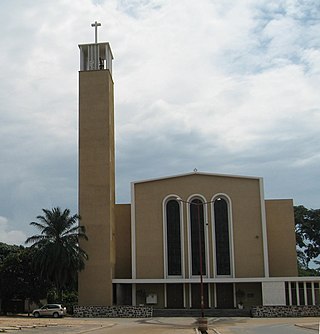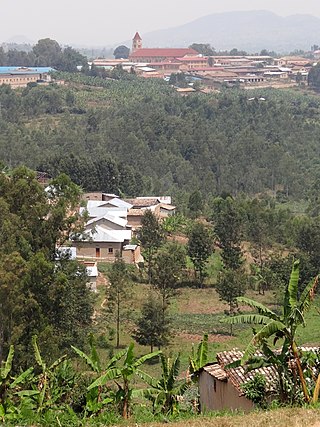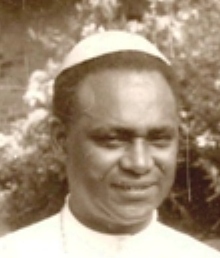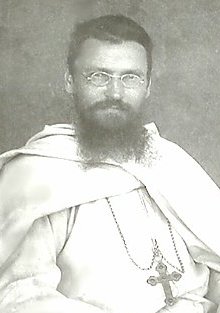Related Research Articles
The Archdiocese of Port Moresby is a Latin Church ecclesiastical jurisdiction or archdiocese of the Catholic Church in Papua New Guinea. Its cathedra is in St. Mary's Cathedral, in Port Moresby, National Capital District.

The Archdiocese of Gitega the Metropolitan See for the Ecclesiastical province of Gitega in Burundi.
The Roman Catholic Archdiocese of Brazzaville is the Metropolitan See for the Ecclesiastical province of Brazzaville in the Republic of the Congo.
The Roman Catholic Archdiocese of Libreville is the Metropolitan See of the Latin Ecclesiastical province covering all Gabon.
The Roman Catholic Archdiocese of Bukavu is the Metropolitan See for the Ecclesiastical province of Bukavu in the Democratic Republic of the Congo.
The Roman Catholic Archdiocese of Mwanza is the Metropolitan See for the Ecclesiastical province of Mwanza in Tanzania.

The Roman Catholic Archdiocese of Bujumbura is the Metropolitan See for the Ecclesiastical province of Bujumbura in Burundi.
The Apostolic Vicariate of Tanganyika was a Catholic apostolic vicariate of the White Fathers missionary order at first centered on the mission of Karema in what is now Tanzania, that included parts of what are now Rwanda, Burundi, Democratic Republic of the Congo, Zambia and Malawi. As the number of missions, schools and converts grew, different regions became distinct vicariates covering portions of the original territory.
The Roman Catholic Diocese of Kabgayi is a diocese located in the city of Kabgayi in the Ecclesiastical province of Kigali in Rwanda.
The Apostolic Vicariate of Southern Nyanza was a Roman Catholic mission territory in Eastern and Central Africa. It was an apostolic vicariate split out from the larger Vicariate of Nyanza in June 1894. It lost territory to the Apostolic Vicariate of Kivu in 1912, and was divided into the vicariates of Bukoba and Mwanza in 1929.

Kabgayi is just south of Gitarama in Muhanga District, Southern Province, Rwanda, 25 miles (40 km) southwest of Kigali. It was established as a Catholic Church mission in 1905. It became the center for the Roman Catholic Church in Rwanda and is the site of the oldest cathedral in the country and of Catholic seminaries, schools and a hospital. The church at first supported the Tutsi ruling elite, but later backed the Hutu majority. During the 1994 Rwandan genocide thousands of Tutsis who had taken refuge here were killed. Some survivors admire the courage of many priests who helped them during those difficult days, like Father Evergiste RUKEBESHA and many others. Later, some Hutus including three bishops and many priests were killed by the rebels RPF soldiers. A mass grave beside the hospital is marked by a memorial. Inside the Basilica are kept the bodies of the three bishops killed by FPR rebels. Two of them were refused by the Rwandan government to be transferred in their own cathedrals.

Aloys Bigirumwami was a Rwandan prelate of the Roman Catholic Church. He served as Bishop of Nyundo from 1959 to 1973, having previously served as its apostolic vicar.

John Joseph Hirth was a Catholic Bishop in German East Africa, known as the founder of the church in Rwanda.
Rubya is the site of a Catholic Church mission to the south of Bukoba near the west bank of Lake Victoria in Muleba District, Kagera Region, Tanzania. A seminary was established at Rubya in 1904, one of the first in German East Africa, as it then was. The seminary still operates. There is a cathedral, a nursing school and a district hospital, all operated by the church.
Joseph Francis Marie Sweens, was a Dutch Roman Catholic missionary bishop who served as the Vicar Apostolic of South Nyanza in German East Africa, later in the British-administered Tanganyika Territory, now Tanzania.
The Apostolic Vicariate of Ruanda was created on 25 April 1922 from the northern part of the former Apostolic Vicariate of Kivu, serving the territory of what is now Rwanda. It was led by Bishop Léon-Paul Classe of the White Fathers. The Apostolic Vicariate of Urundi was created on the same date, serving the territory of what is now Burundi and led by Bishop Julien-Louis-Edouard-Marie Gorju.

Léon-Paul Classe, M.Afr. was a Catholic priest who was Vicar Apostolic of the Apostolic Vicariate of Ruanda, in what is now Rwanda, from 1922 until his death in 1945. During his time as a missionary priest and then bishop a great many Rwandans were converted to Christianity. Classe was influential in persuading the Belgian colonial administration to favor the Tutsis as a ruling caste in the country over the Hutu majority.
Laurent-François Déprimoz, M. Afr. was a Catholic priest who was Vicar Apostolic of the Apostolic Vicariate of Ruanda and then of the Apostolic Vicariate of Kabgayi.
Kivu was the name for a large "Region" in the Democratic Republic of Congo under the rule of Mobutu Sese Seko.

St Léon Minor Seminary of Kabgayi is a Catholic church minor seminary located in Kabgayi, Southern province of Rwanda. The school is owned by Kabgayi Diocese of Catholic Church of Rwanda. Established in 1913, the seminary is the oldest formal school in Rwanda. The minor seminary of Kabgayi had educated a number of notable people both in the church and the politics. The seminary's alumni include two former Presidents of Republic of Rwanda, several catholic church bishops, two former Presidents of Rwanda's senate, tens of ministers, several members of the parliament and hundreds of Catholic priests.
References
Citations
Sources
- "Archdiocese of Gitega". Catholic Hierarchy. Retrieved 2013-04-05.[ self-published source ]
- "Diocese of Kabgayi Rwanda". GCatholic.org. Retrieved 2013-04-05.
- "Metropolitan Archdiocese of Bukavu Congo-Kinshasa" . Retrieved 2013-04-05.
- Shorter, Aylward (2011-12-01). Les Pères Blancs au temps de la conquête coloniale: Histoire des Missionnaires d'Afrique (1892-1914). KARTHALA Editions. ISBN 978-2-8111-0575-4 . Retrieved 2013-03-26.